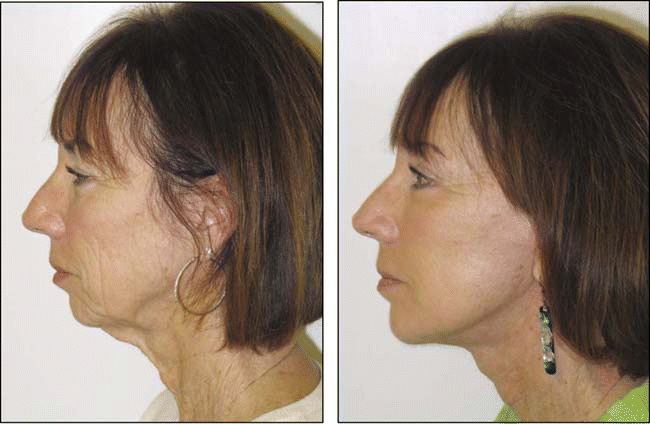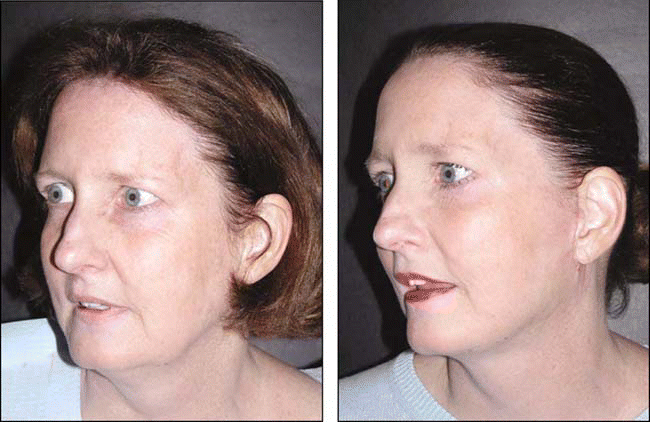Mini facelifts are gaining popularity, because they can restore the face and neck to a more youthful appearance but are performed under local anesthesia and are therefore safer and less expensive than a traditional facelift. ENToday spoke with two surgeons who have developed variations of mini facelifts-Greg S. Morganroth, MD, and A. David Rahimi, MD-to gain a better understanding of the advantages of these procedures. Dr. Morganroth has developed the Facial Lipo-Lift and Extended Facial Lipo-Lift techniques, and Dr. Rahimi has developed the Tuliplift technique.
Explore This Issue
July 2006Natural Look
The goal of the facelifts I perform is to achieve a dramatic and natural result with minimal scarring. I want my patients to look younger without the classic signs of having had a facelift. People should look at her and think, ‘She looks younger, but I don’t know why’, said Greg S. Morganroth, MD, who is Assistant Clinical Professor of Dermatology at the University of California at San Francisco and Adjunct Clinical Assistant Professor of Otolaryngology-Head and Neck Surgery at Stanford University in Palo Alto, Calif.
The two versions of the Facial Lipo-Lift are performed with local anesthesia. The first, referred to as the Facial Lipo-Lift, consists of facial and neck liposuction combined with a vertical vector, anterior short-scar facelift. The short scar incision extends from the sideburn inferiorly along the ear around the earlobe and up the post-auricular crease to the top third of the ear.

The incision differs from the S-Lift by extending the incision in to post-auricular region to hide the dog-ear behind the ear and to provide for greater plication of the superficial musculoaponeurotic system (SMAS) and skin excision. Undermining extends 5 to 6 cm anterior to the ear and 2.25 cm posterior to the ear.
The difference between the Facial Lipo-Lift and a traditional facelift is that the procedure is performed with local anesthesia, there is only a preauricular flap with limited undermining and plication, and the neck is managed by liposuction without scissor undermining or plication of the platysma muscle, Dr. Morganroth explained.
Extended Facial Lipo-Lift
The second type is called the Extended Facial Lipo-Lift, and is described as a traditional Webster-style facelift performed under local anesthesia combined with liposuction of the neck. In contrast with the non-extended version of the Lipo-Lift, the extended procedure includes an incision that extends 4 to 6 cm into the occipital scalp to form a post-auricular flap that allows for plication of the platysmal muscle and excision of excess neck skin.
To create a natural result, all tightening of the SMAS and platysma is performed in a vertical vector, Dr. Morganroth explained. No horizontal vectors are used, in contrast to the traditional facelift, he added. Dr. Morganroth uses a Mohs’ surgeon’s approach to the closure of the incision of the Facial Lipo-Lift, using multi-layered closures to repair the incisions. This technique avoids tension on the incision, subsequent spreading of the scar, and the need for subsequent scar revision or camouflage by a change in hair style, he explained.
The traditional facelift is commonly performed with only superficial sutures and staples for the skin closure and has a higher risk of incision spreading, causing widened scars and inferior displacement of the earlobe, known as a ‘pixie-ear deformity.’ I prevent this by anchoring the skin flap to mastoid fascia behind the ear and cartilage and carotid fascia in front of the ear with buried sutures, he explained.
The type of liposuction he uses is called tumescent liposuction; a diluted lidocaine and epinephrine solution (0.1% to 0.3%) infiltrates the skin and is used for local anesthesia. This numbs the skin, plumps it up by expanding the adipose compartment, and constricts the blood vessels. The patient is totally awake during the procedure and may have a sensation of pressure, much the way they would experience a dentist’s drill under local anesthesia. There is no pain, and patients can ambulate on their own afterwards, he said.
Mini-Lift Advantages
Both procedures are done at Dr. Morganroth’s office, which has a Medicare-approved operating room. Because neither general anesthesia nor an anesthesiologist is needed, the Extended Facial Lipo-Lift is less expensive, safer, and has less downtime than a traditional facelift. There is no need for drains, because there is little or no bleeding. Recovery is faster. Patients can take care of themselves and perform activities of daily living on day 1, go out for lunch on day 4 or 5, and have the sutures out on day 7.
Patients have to take a week off of work to have the Extended Facial Lipo-Lift, Dr. Morganroth said.
Other advantages of the Extended Facial Lipo-Lift over a traditional Webster-style facelift include minimal post-operative pain, minimal bleeding and bruising, and low risk of nerve injury due to expansion of the adipose layer, he said.
Candidates for Lipo-Lifts
Candidates for the Facial Lipo-Lift include people with mild facial ptosis and jowling, but good skin elasticity and minimal to no banding of the neck muscles. These are usually women in their 40s and 50s, Dr. Morganroth explained.
The Extended Facial Lipo-Lift should be used in people with wrinkled neck skin, sagging neck muscles, and patients in need of neck skin excision. This procedure can be performed on anyone who is a candidate for a traditional facelift, he said.
People who age primarily with volume loss and not ptosis of the skin supportive tissue may not be candidates for facelifts. Instead, Dr. Morganroth suggested volume replacement, which can be done with injections of ply-L-lactic acid (Sculptra) or microlipoinjections.
Combination Procedures
Both the Facial Lipo-Lift and the Extended Facial Lipo-Lift lend themselves to combination with other procedures, Dr. Morganroth said, all of which are conducted in one sitting under local anesthesia. These adjunctive procedures include upper and lower blepharoplasty, chin implants, laser resurfacing of the mouth and eyes, and chemical peels to the rest of the face.
The Tuliplift addresses three vectors of the face and neck: under the eye and cheek (horizontal vector); the jowl (combination of horizontal and vertical vectors); and the neck (vertical vector).
At the 2005 Annual Meeting of the American Society for Dermatologic Surgery, Dr. Morganroth presented a series of 43 patients who underwent the combination of Extended Facial Lipo-Lift plus the other procedures mentioned above and found that there were no serious complications, patients could return to unlimited social activities within 10 days, and the average number of post-operative pain medications was 10.8 pills, which represent less than 1.5 days’ worth of analgesics, he said.
Furthermore, three of these patients had undergone a prior facelift under general anesthesia. All three of these patients reported the highest rating of ‘much better’ when comparing local to general anesthesia facelifts in terms of post-operative discomfort and recovery, he said.
The Tuliplift
The Tuliplift is a mini facelift that can be tailored to the needs of the individual patient, explained David Rahimi, MD, who is a dermatologist and cosmetic surgeon in private practice at Forever Young in Los Angeles, Calif. I have been using the Tuliplift for over five years with excellent and lasting results, he added.

One size does not fit all, he said. The Tuliplift can be customized for each person’s face. I can assess and tighten parts of the lift to achieve a better, more customized fit. Think of the procedure as involving three petals that are actually three lifting levers that can be customized, he explained.
The Tuliplift is performed under local anesthesia with tumescent anesthetic technique (i.e., using small amounts of anesthesia to numb the skin). The procedure addresses three vectors of the face and neck: 1) under the eye and cheek-horizontal vector; 2) the jowl-combination of horizontal and vertical vectors; and 3) the neck-vertical vector.
The components of the Tuliplift add up to more than the sum of the parts. If a person’s neck sags more than other parts of the face, this procedure allows me to tighten the neck more than the rest of the face, Dr. Rahimi said.
He asks patients to bring in a photograph from 10 or 15 years ago to use as a guide for the procedure. This procedure is not designed to make the patient look different. I visualize it as reconstruction so I can restore the way they looked when they were younger. By contrast, a nose job is designed to make a patient look different, he continued.
Procedural Details
The procedure entails liposuction of the neck and jowl. The fat is stored in a tissue bank in case it is needed at the end of the procedure for volume replacement or for follow-up visits. A corsette platysmoplasty is used to tighten the bands under the neck and bring them together. SMAS of the three vectors is used to tighten the facial muscles. Then the skin is redraped over the underlying structures. Dr. Rahimi noted that pulling on the skin can cause scarring.
The Tuliplift has several advantages over conventional facelift techniques, he noted, including greater safety because it is done under local anesthesia, not general anesthesia. Dr. Rahimi said that most complications with traditional facelifts are associated with general anesthesia. The risks of the Tuliplift are basically the risks of local anesthesia-allergic reaction and bleeding.
Other complications of traditional facelifts such as bleeding, scarring, and infections can be treated, but when a patient doesn’t wake up from general anesthesia, there is no treatment, he stated.
The Tuliplift is associated with a faster recovery compared with traditional facelift procedures, Dr. Rahimi stated. The sutures come out in one week and the patient is usually able to return to work within 10 days. Also, the Tuliplift is less expensive than a traditional facelift. Conventional facelifts cost anywhere from $10,000 to $20,000. The cost of the Tuliplift ranges from $5800 to $6800; that price includes anesthesia, blood work, and all associated costs.
Most people with signs of aging are candidates for the procedure, but you have to choose the right patient, he cautioned. Patients who do not want to be awake and aware of the surgery would require a traditional facelift with general anesthesia. During a Tuliplift, the patient will be in twilight sleep and will be aware of the surgery. Also, patients with a heavy sagging neck who have lost a lot of weight recently would need a full facelift.
In Favor of Mini Facelifts
Mini facelifts are being performed all over the United States., explained Mack Cheney, MD, a Professor of Otology and Laryngology and Plastic Surgery at Massachusetts Eye and Ear Infirmary in Boston. In his opinion, all of the mini facelift techniques achieve a more natural look and are safer compared with a traditional facelift. Also, there is minimal scarring with these techniques.
For the right person, a mini facelift is great. The change is minimal and more natural, he commented. Dr. Cheney noted that there are some people who want dramatic tightening of the skin and those people are better candidates for a traditional facelift.
Durability of most mini facelifts is from five to seven years, and then the patient can come in for a further surgical adjustment under local anesthesia if needed.
Dr. Cheney’s variation does not utilize liposuction techniques. In his view, it would be difficult to get consistent results without lifting the skin to tighten the SMAS.
©2006 The Triological Society
Leave a Reply